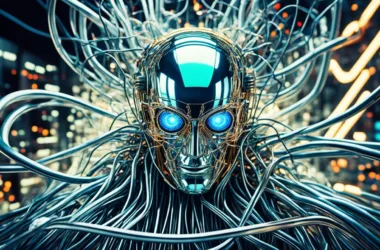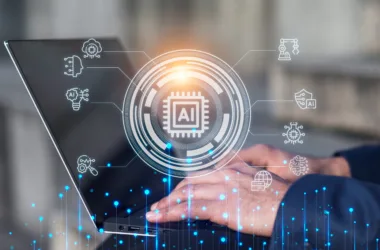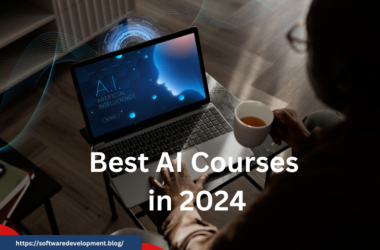Artificial intelligence (AI) and machine learning (ML) are two terms often used interchangeably, but they have distinct differences. To truly grasp their significance, it’s important to understand what sets them apart.
AI refers to the use of technologies that enable machines and computers to mimic human intelligence. It encompasses a wide range of approaches and algorithms that aim to replicate human cognitive functions and solve complex problems. On the other hand, ML is a subset of AI that focuses on teaching machines to learn and improve from experience using algorithms.
While AI has a broader scope and includes various technologies such as deep learning, robotics, expert systems, and natural language processing, ML is specifically concerned with training machines to identify patterns and perform specific tasks.
Organizations today need to understand the nuances between AI and ML to effectively leverage these technologies and drive innovation. Let’s delve deeper into the concepts and explore their similarities and differences.
Key Takeaways:
- AI and ML are closely related but have distinct differences.
- AI aims to simulate human intelligence, while ML focuses on teaching machines to learn from data and perform specific tasks.
- AI encompasses a wider range of technologies, including ML, deep learning, robotics, expert systems, and natural language processing.
- ML uses algorithms to analyze data and improve performance over time.
- Understanding the differences between AI and ML is crucial for organizations to leverage their potential effectively.
What is Artificial Intelligence?
Artificial intelligence (AI) is a broad field that encompasses the use of technologies to enable machines and computers to perform cognitive functions associated with human intelligence. AI technologies are designed to mimic human reasoning, learning, and problem-solving abilities.
AI involves the development of systems that can understand and respond to natural language, analyze data, make recommendations, and perform tasks that traditionally require human intelligence. These cognitive functions are implemented in various AI technologies, such as machine learning, natural language processing, computer vision, and expert systems.
One of the key components of AI is machine learning, which is a subset of AI technologies. Machine learning algorithms enable machines to learn and improve from experience without being explicitly programmed. By analyzing large amounts of data, machine learning algorithms can identify patterns and make accurate predictions or decisions based on learned insights.
AI technologies have a wide range of applications in various industries. In healthcare, AI is used for medical image analysis, disease diagnosis, personalized medicine, and drug discovery. In finance, AI technologies are employed for fraud detection, risk assessment, and algorithmic trading. AI is also used in autonomous vehicles, virtual assistants, and cybersecurity systems, to name just a few examples.
AI encompasses technologies that enable machines to perform cognitive functions associated with human intelligence, such as understanding language, analyzing data, and making recommendations.
AI is not a single system or technology but rather a collection of technologies working together to enable machines to exhibit intelligent behavior. These technologies continue to evolve and improve, expanding the possibilities of what AI can achieve.
To summarize, artificial intelligence refers to the use of technologies that enable machines to perform cognitive functions associated with human intelligence. It encompasses a wide range of technologies, including machine learning, and has numerous applications in various industries.
What is Machine Learning?
Machine learning is a subset of AI that focuses on enabling machines or systems to learn and improve from experience without explicit programming. It leverages ML algorithms to analyze large amounts of data, extract meaningful insights, and make informed decisions. By learning from experience, machines can develop the ability to automatically identify patterns and adapt their behavior accordingly.
A key aspect of machine learning is its reliance on data analysis to drive learning and decision-making. The algorithms sift through vast amounts of data, searching for relevant patterns and correlations. This allows the system to build a model that represents its understanding of the underlying data and its relationships.
Machine learning gives computers the ability to learn and improve from experience, just like humans do.
The output of a machine learning model is a program that has learned from the training data and can make predictions or decisions on new, unseen data. This empowers organizations to make informed decisions based on data-driven insights, leading to improved efficiency and effectiveness in various domains.
Types of Machine Learning Algorithms
Machine learning algorithms can be categorized into different types based on their learning approach and the nature of the data they process. Some common types include:
- Supervised Learning: In this approach, the model learns from labeled training data to make predictions or classifications on new, unseen data.
- Unsupervised Learning: Here, the model learns patterns and structures in unlabeled data without any specific guidance, allowing it to discover insights and relationships.
- Reinforcement Learning: This type involves training a model through a trial-and-error process, where it receives feedback in the form of rewards or penalties based on its actions.
These different algorithms form the foundation of machine learning and enable it to tackle a wide range of problem domains, from image recognition to natural language processing and beyond.
Machine Learning in Practice
Machine learning has found applications across various industries, transforming the way businesses operate and make decisions. Some notable examples include:
| Industry | Machine Learning Application |
|---|---|
| Healthcare | Patient diagnosis, medical imaging analysis, drug discovery |
| Finance | Fraud detection, credit risk assessment, algorithmic trading |
| Retail | Personalized marketing, demand forecasting, inventory management |
| Manufacturing | Predictive maintenance, quality control, supply chain optimization |
These applications demonstrate the broad impact of machine learning and its ability to enhance decision-making, streamline operations, and improve outcomes across various sectors.
Relationship Between AI and Machine Learning
Artificial Intelligence (AI) and Machine Learning (ML) are closely connected, with ML being an important application of AI. AI serves as the broader concept and encompasses various approaches and algorithms, including ML, deep learning, robotics, expert systems, and natural language processing. ML, on the other hand, is a subset of AI that focuses on teaching machines to learn and improve from experience using algorithms.
Imagine AI as an umbrella category that encapsulates different fields, with ML being one of them. This relationship helps clarify the difference between AI and ML and how they can be applied in different contexts. Let’s take a closer look at some of these subfields:
Deep Learning:
Deep learning is a subset of ML that focuses on training artificial neural networks to recognize patterns and make predictions. It has revolutionized fields such as computer vision, speech recognition, and natural language processing.
Robotics:
Robotics combines AI and ML to develop machines that can perceive, understand, and interact with the physical world. Robots are trained using ML algorithms to perform tasks autonomously or in collaboration with humans.
Expert Systems:
Expert systems are AI programs that emulate human expertise in specific domains. These systems use ML techniques to learn from expert knowledge and make informed decisions or provide recommendations.
Natural Language Processing:
Natural Language Processing (NLP) focuses on enabling machines to interact and understand human language. ML algorithms are used to analyze and process text, speech, and other forms of human communication.
By understanding the relationship between AI and ML and their respective applications, organizations can leverage these technologies to drive innovation and achieve their goals in various fields.
| AI Concepts | Description |
|---|---|
| Machine Learning | A subset of AI that focuses on teaching machines to learn and improve from experience using algorithms. |
| Deep Learning | A subset of ML that trains artificial neural networks to recognize patterns and make predictions. |
| Robotics | Combines AI and ML to develop machines that can interact with the physical world. |
| Expert Systems | AI programs that emulate human expertise in specific domains. |
| Natural Language Processing | Enables machines to interact and understand human language. |
Key Differences Between AI and ML
When it comes to understanding artificial intelligence (AI) and machine learning (ML), it’s important to grasp their key differences. AI is designed to simulate human intelligence and solve complex problems, while ML focuses on identifying patterns and performing specific tasks with accuracy.
Let’s dive deeper into the main distinctions:
- AI simulates human intelligence: The primary goal of AI is to replicate human intelligence by enabling machines to understand, reason, and make decisions like humans do. It aims to solve complex, open-ended problems by applying cognitive functions and providing human-like responses.
- ML identifies patterns: In contrast, ML focuses on teaching machines to identify patterns in data and make predictions or take actions based on those patterns. It uses algorithms that analyze large amounts of data and learn from their insights to improve performance.
- ML training algorithms: ML algorithms are trained to learn from labeled data to identify patterns and make accurate predictions. The more data they are exposed to, the better they become at recognizing patterns and delivering precise results.
- Specific task performance: While AI systems can perform a wide range of tasks across various domains due to their human-like intelligence, ML has a more limited scope. ML is typically used for specific applications, such as image recognition, natural language processing, fraud detection, and recommendation systems.
By understanding these distinctions, organizations can determine whether they need to leverage AI or ML for their specific use cases. While AI offers the potential for human-like intelligence, ML provides accurate task performance and pattern recognition capabilities.
Benefits of AI and ML Integration
The integration of AI and ML brings significant benefits to organizations. By harnessing the power of these technologies, businesses can unlock new opportunities and drive innovation across various industries.
Enhanced Data Analysis and Decision-Making
Through AI and ML technologies, organizations can analyze and activate a wider range of data sources, gaining valuable insights and improving data integrity. This enables more informed decision-making, as data-driven strategies lead to better outcomes and competitive advantages.
Increased Operational Efficiency
AI and ML integration automates repetitive tasks, streamlines operations, and optimizes resource allocation. This boosts efficiency, reduces costs, and enables teams to focus on higher-value activities. With AI and ML, businesses can achieve greater productivity and operational excellence.
Integration of Predictive Analytics
Predictive analytics plays a crucial role in driving business success. By leveraging AI and ML, organizations can integrate predictive analytics into their existing processes, forecasting future trends, and gaining a competitive edge. This empowers businesses to anticipate customer demands, optimize inventory management, and make proactive business decisions.
The integration of AI and ML enables organizations to leverage predictive analytics and make proactive, data-driven decisions
Enhanced Customer and Employee Experiences
AI and ML technologies have the potential to transform customer and employee experiences. From personalized recommendations to intelligent chatbots, organizations can leverage AI and ML to deliver tailored and engaging interactions. This leads to improved customer satisfaction, loyalty, and optimized employee workflows.
Real-World Examples:
Companies like Walmart and Wayfair have successfully integrated AI and ML into their operations, reaping the benefits of enhanced data analysis, improved decision-making, increased operational efficiency, and superior customer experiences.
Benefits of AI and ML Integration
| Benefit | Description |
|---|---|
| Enhanced Data Analysis | AI and ML enable organizations to analyze a wider range of data sources and improve data integrity. |
| Improved Decision-Making | Data-driven strategies powered by AI and ML lead to more informed decision-making and better outcomes. |
| Increased Operational Efficiency | AI and ML automation streamline operations, optimize resource allocation, and boost overall efficiency. |
| Integration of Predictive Analytics | By leveraging AI and ML, organizations can integrate predictive analytics into business processes, gaining a competitive edge. |
| Enhanced Customer and Employee Experiences | AI and ML technologies improve customer satisfaction and optimize employee workflows, delivering personalized experiences. |
Applications of AI and ML
Artificial intelligence (AI) and machine learning (ML) have a wide range of applications across various industries. Let’s explore some of the key areas where AI and ML are making a significant impact:
Healthcare
In the healthcare industry, AI and ML technologies are revolutionizing patient care and treatment. The applications include:
- Healthcare: AI is used for patient health record analysis, outcome forecasting, drug development, diagnostics, and patient monitoring.
Manufacturing
In the manufacturing sector, AI and ML are streamlining processes and improving operational efficiency. Here are some of the applications:
- Manufacturing: AI and ML technologies are used for machine monitoring, predictive maintenance, IoT analytics, and operational efficiency.
Banking
The banking industry benefits from AI and ML in various ways, enhancing security and customer experience. The applications include:
- Banking: AI and ML are used in fraud detection, cybersecurity, customer service automation, and identity authentication.
Supply Chain Management
AI and ML techniques are also employed in optimizing supply chain operations. Some of the applications include:
- Supply Chain: AI and ML assist in supply chain management, risk assessment, network optimization, and business process automation.
These are just a few examples of how AI and ML are transforming industries. The applications of AI and ML continue to expand, providing organizations with valuable insights, efficiency, and innovation.
| Industry | AI and ML Applications |
|---|---|
| Healthcare | Patient health record analysis, outcome forecasting, drug development, diagnostics, patient monitoring |
| Manufacturing | Machine monitoring, predictive maintenance, IoT analytics, operational efficiency |
| Banking | Fraud detection, cybersecurity, customer service automation, identity authentication |
| Supply Chain | Supply chain management, risk assessment, network optimization, business process automation |
The Future of AI and ML
With the rapid advancements in artificial intelligence (AI) and machine learning (ML), the future of these technologies looks incredibly promising. The global market size for AI is projected to experience significant growth in the coming years, owing to its potential to revolutionize various industries and sectors.
As businesses continue to harness the power of AI and ML, one of the primary focuses will be on analyzing vast amounts of data to extract valuable insights. Data-driven insights will enable organizations to make informed decisions, drive innovation, and gain a competitive edge in the market. By leveraging AI and ML capabilities, companies can uncover hidden patterns and trends within their data, leading to more accurate predictions and improved operational efficiency.
Automation is another key aspect of the future of AI and ML. As technology continues to advance, organizations are increasingly seeking solutions to automate repetitive processes, reduce manual effort, and streamline operations. Through intelligent automation powered by AI and ML, businesses can optimize workflows, enhance productivity, and allocate resources more effectively. Automation also enables organizations to focus on high-value tasks that require human intervention, ultimately leading to improved customer satisfaction and overall business performance.
Speaking of customer satisfaction, AI and ML have the potential to transform the way companies interact with their customers. By leveraging these technologies, businesses can personalize customer experiences, anticipate needs, and provide tailored recommendations. Whether it’s chatbots providing real-time assistance or personalized product recommendations based on customer preferences, AI and ML can help companies deliver exceptional customer service and drive customer loyalty.
In summary, the future of AI and ML is characterized by the continuous growth of the global market, the utilization of data-driven insights, the automation of processes, and the improvement of customer satisfaction. These technologies will continue to shape various industries, empower organizations to make data-driven decisions, and revolutionize the way we live and work.
Building Skills in AI and ML
To stay up to date with the advancements in AI and ML, individuals can benefit from various courses and training programs. One such course is “AI for Everyone” offered by DeepLearning.AI, which is designed to introduce beginners to the core concepts of machine learning, neural networks, deep learning, and data science. By enrolling in this course, participants can gain a deeper understanding of these technologies and their applications in real-world scenarios.
Course Highlights:
- Learn the fundamentals of AI and ML
- Explore the basics of neural networks and deep learning
- Understand the principles of data science and analysis
- Gain hands-on experience with practical exercises and projects
- Interact with industry experts and instructors
Whether you’re a beginner looking to enter the field of AI and ML or an experienced professional seeking to enhance your skills, this course provides valuable knowledge and insights. By acquiring expertise in AI, machine learning, deep learning, and data science, individuals can contribute significantly to the development and deployment of AI-driven solutions across various industries.
The AI for Everyone course provided me with a solid foundation in AI and ML. The instructor’s expertise and the hands-on projects helped me understand the practical aspects of these technologies. I highly recommend this course to anyone interested in exploring the exciting field of AI.
Investing in AI and ML training not only enables personal growth but also opens up new career opportunities. As organizations continue to embrace AI-driven strategies, the demand for professionals with expertise in AI, machine learning, deep learning, and data science is on the rise.
| Course Name | Provider | Duration |
|---|---|---|
| AI for Everyone | DeepLearning.AI | 4 weeks |
| Machine Learning Training | Online Learning Academy | 8 weeks |
| Deep Learning Fundamentals | Data Science Institute | 6 weeks |
| Data Science Bootcamp | Global Tech University | 12 weeks |
Enrolling in AI and ML courses not only helps individuals keep up with advancements but also demonstrates their commitment to professional development. By equipping themselves with the necessary skills and knowledge, individuals can stay relevant and contribute to the growth and innovation in an increasingly AI-driven world.
Conclusion
In conclusion, machine learning and AI are closely intertwined but have distinct differences. Artificial intelligence (AI) encompasses a wide range of technologies that aim to mimic human intelligence in machines. On the other hand, machine learning (ML) is a subset of AI that focuses on teaching machines to learn and improve from experience using algorithms.
Understanding the key differences between machine learning and AI is crucial for organizations looking to harness the power of these technologies. While AI has a broader scope and can perform various tasks, ML is specific, focusing on identifying patterns and performing specific tasks accurately.
As AI and machine learning continue to evolve, their applications will shape the future of technology across industries. Organizations and individuals can benefit from these advancements by leveraging them to drive innovation, enhance operations, and deliver better customer experiences. By staying up-to-date with the latest developments in machine learning and AI, we can tap into their immense potential and unlock new possibilities.






